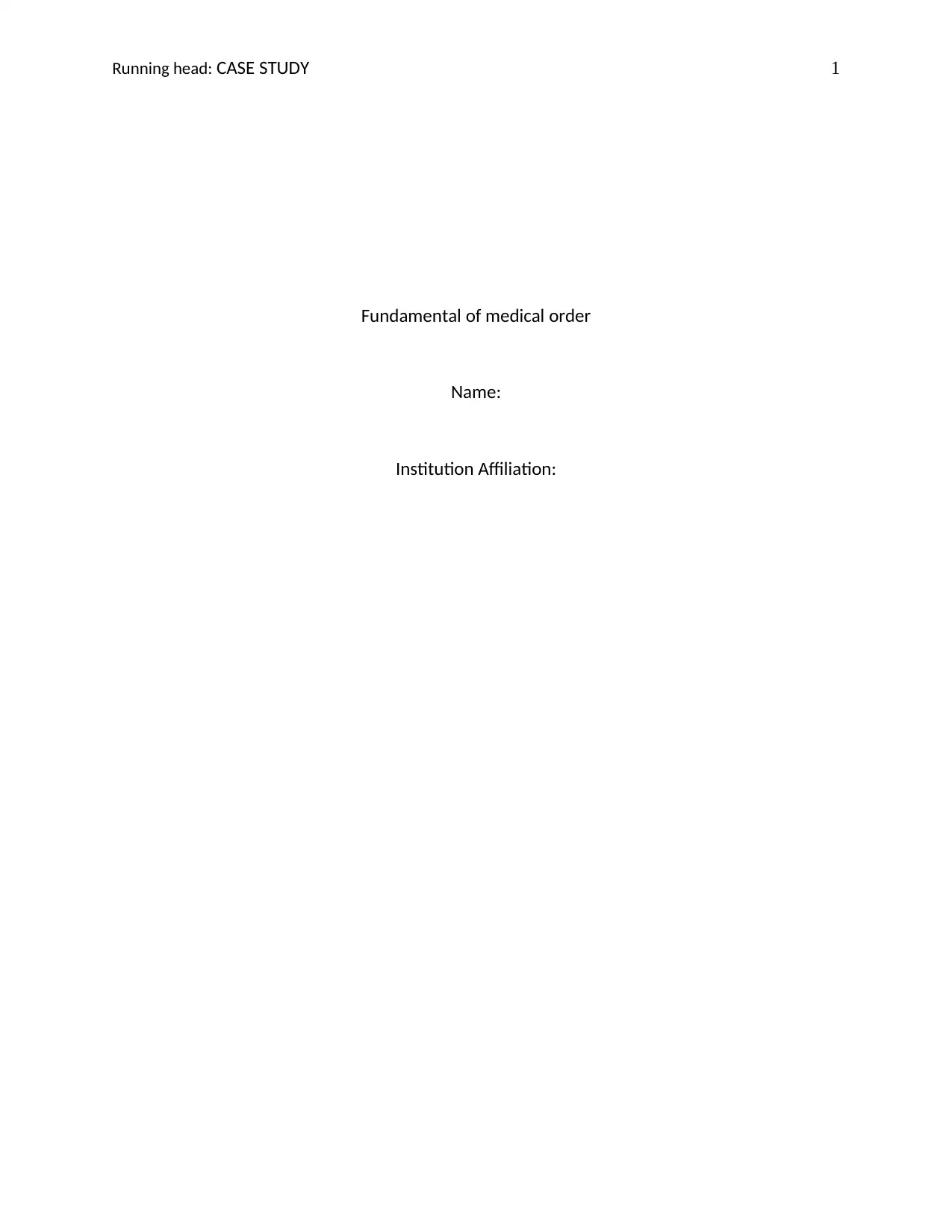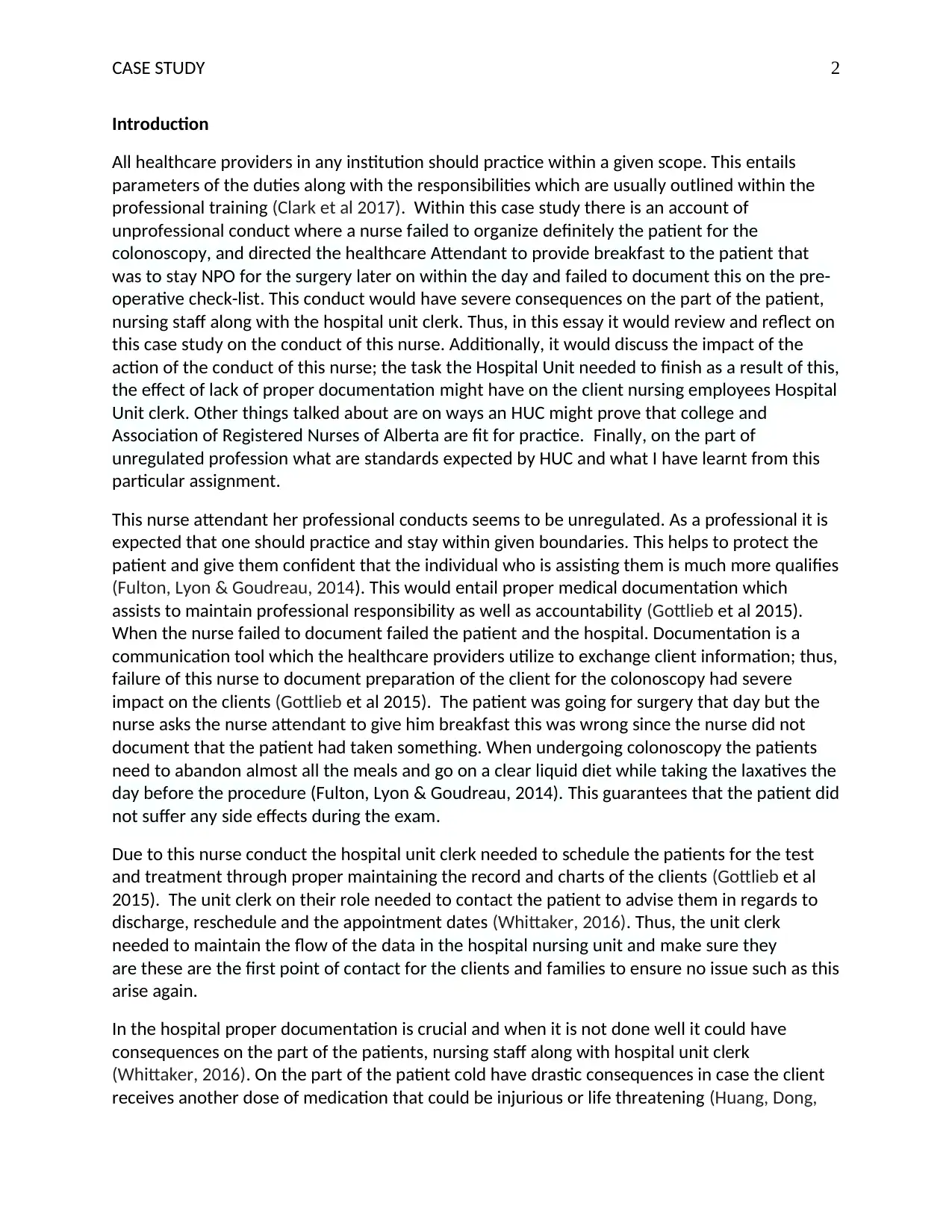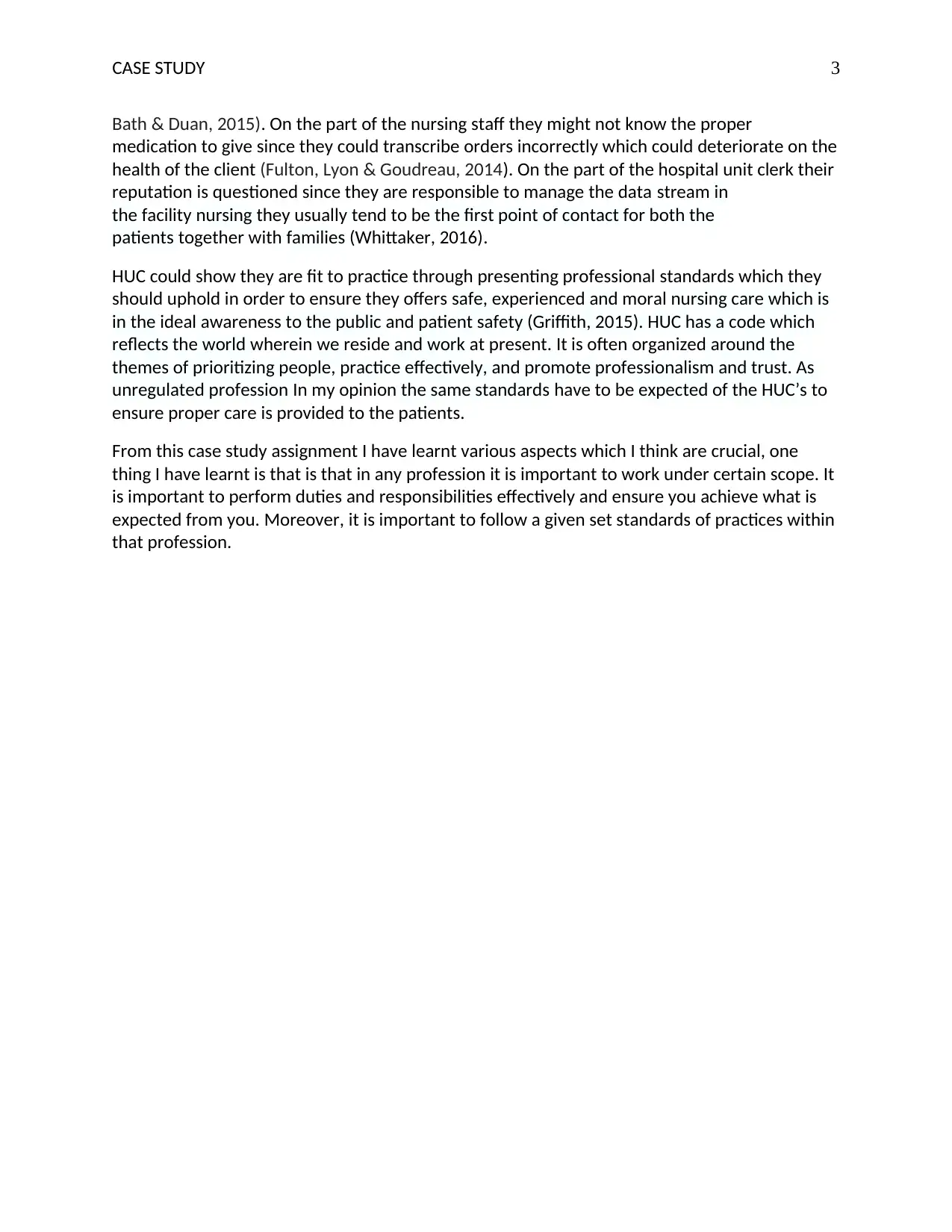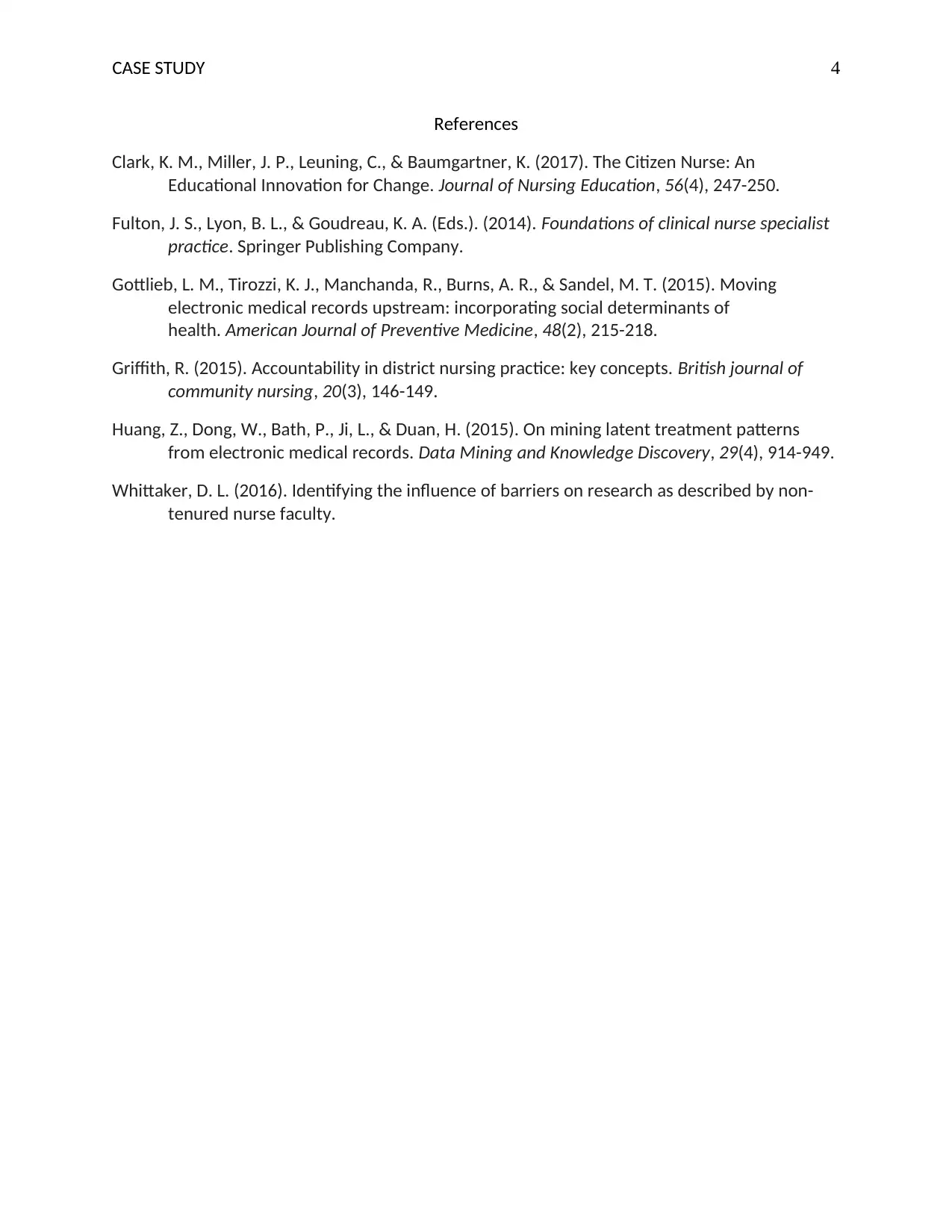Fundamental of Medical Order - Case Study
VerifiedAdded on 2023/06/10
|4
|1178
|308
AI Summary
This case study discusses the impact of unprofessional conduct of a nurse on the patient, nursing staff, and hospital unit clerk. It also talks about the importance of proper documentation and how an HUC can prove their fitness for practice.
Contribute Materials
Your contribution can guide someone’s learning journey. Share your
documents today.

Running head: CASE STUDY 1
Fundamental of medical order
Name:
Institution Affiliation:
Fundamental of medical order
Name:
Institution Affiliation:
Secure Best Marks with AI Grader
Need help grading? Try our AI Grader for instant feedback on your assignments.

CASE STUDY 2
Introduction
All healthcare providers in any institution should practice within a given scope. This entails
parameters of the duties along with the responsibilities which are usually outlined within the
professional training (Clark et al 2017). Within this case study there is an account of
unprofessional conduct where a nurse failed to organize definitely the patient for the
colonoscopy, and directed the healthcare Attendant to provide breakfast to the patient that
was to stay NPO for the surgery later on within the day and failed to document this on the pre-
operative check-list. This conduct would have severe consequences on the part of the patient,
nursing staff along with the hospital unit clerk. Thus, in this essay it would review and reflect on
this case study on the conduct of this nurse. Additionally, it would discuss the impact of the
action of the conduct of this nurse; the task the Hospital Unit needed to finish as a result of this,
the effect of lack of proper documentation might have on the client nursing employees Hospital
Unit clerk. Other things talked about are on ways an HUC might prove that college and
Association of Registered Nurses of Alberta are fit for practice. Finally, on the part of
unregulated profession what are standards expected by HUC and what I have learnt from this
particular assignment.
This nurse attendant her professional conducts seems to be unregulated. As a professional it is
expected that one should practice and stay within given boundaries. This helps to protect the
patient and give them confident that the individual who is assisting them is much more qualifies
(Fulton, Lyon & Goudreau, 2014). This would entail proper medical documentation which
assists to maintain professional responsibility as well as accountability (Gottlieb et al 2015).
When the nurse failed to document failed the patient and the hospital. Documentation is a
communication tool which the healthcare providers utilize to exchange client information; thus,
failure of this nurse to document preparation of the client for the colonoscopy had severe
impact on the clients (Gottlieb et al 2015). The patient was going for surgery that day but the
nurse asks the nurse attendant to give him breakfast this was wrong since the nurse did not
document that the patient had taken something. When undergoing colonoscopy the patients
need to abandon almost all the meals and go on a clear liquid diet while taking the laxatives the
day before the procedure (Fulton, Lyon & Goudreau, 2014). This guarantees that the patient did
not suffer any side effects during the exam.
Due to this nurse conduct the hospital unit clerk needed to schedule the patients for the test
and treatment through proper maintaining the record and charts of the clients (Gottlieb et al
2015). The unit clerk on their role needed to contact the patient to advise them in regards to
discharge, reschedule and the appointment dates (Whittaker, 2016). Thus, the unit clerk
needed to maintain the flow of the data in the hospital nursing unit and make sure they
are these are the first point of contact for the clients and families to ensure no issue such as this
arise again.
In the hospital proper documentation is crucial and when it is not done well it could have
consequences on the part of the patients, nursing staff along with hospital unit clerk
(Whittaker, 2016). On the part of the patient cold have drastic consequences in case the client
receives another dose of medication that could be injurious or life threatening (Huang, Dong,
Introduction
All healthcare providers in any institution should practice within a given scope. This entails
parameters of the duties along with the responsibilities which are usually outlined within the
professional training (Clark et al 2017). Within this case study there is an account of
unprofessional conduct where a nurse failed to organize definitely the patient for the
colonoscopy, and directed the healthcare Attendant to provide breakfast to the patient that
was to stay NPO for the surgery later on within the day and failed to document this on the pre-
operative check-list. This conduct would have severe consequences on the part of the patient,
nursing staff along with the hospital unit clerk. Thus, in this essay it would review and reflect on
this case study on the conduct of this nurse. Additionally, it would discuss the impact of the
action of the conduct of this nurse; the task the Hospital Unit needed to finish as a result of this,
the effect of lack of proper documentation might have on the client nursing employees Hospital
Unit clerk. Other things talked about are on ways an HUC might prove that college and
Association of Registered Nurses of Alberta are fit for practice. Finally, on the part of
unregulated profession what are standards expected by HUC and what I have learnt from this
particular assignment.
This nurse attendant her professional conducts seems to be unregulated. As a professional it is
expected that one should practice and stay within given boundaries. This helps to protect the
patient and give them confident that the individual who is assisting them is much more qualifies
(Fulton, Lyon & Goudreau, 2014). This would entail proper medical documentation which
assists to maintain professional responsibility as well as accountability (Gottlieb et al 2015).
When the nurse failed to document failed the patient and the hospital. Documentation is a
communication tool which the healthcare providers utilize to exchange client information; thus,
failure of this nurse to document preparation of the client for the colonoscopy had severe
impact on the clients (Gottlieb et al 2015). The patient was going for surgery that day but the
nurse asks the nurse attendant to give him breakfast this was wrong since the nurse did not
document that the patient had taken something. When undergoing colonoscopy the patients
need to abandon almost all the meals and go on a clear liquid diet while taking the laxatives the
day before the procedure (Fulton, Lyon & Goudreau, 2014). This guarantees that the patient did
not suffer any side effects during the exam.
Due to this nurse conduct the hospital unit clerk needed to schedule the patients for the test
and treatment through proper maintaining the record and charts of the clients (Gottlieb et al
2015). The unit clerk on their role needed to contact the patient to advise them in regards to
discharge, reschedule and the appointment dates (Whittaker, 2016). Thus, the unit clerk
needed to maintain the flow of the data in the hospital nursing unit and make sure they
are these are the first point of contact for the clients and families to ensure no issue such as this
arise again.
In the hospital proper documentation is crucial and when it is not done well it could have
consequences on the part of the patients, nursing staff along with hospital unit clerk
(Whittaker, 2016). On the part of the patient cold have drastic consequences in case the client
receives another dose of medication that could be injurious or life threatening (Huang, Dong,

CASE STUDY 3
Bath & Duan, 2015). On the part of the nursing staff they might not know the proper
medication to give since they could transcribe orders incorrectly which could deteriorate on the
health of the client (Fulton, Lyon & Goudreau, 2014). On the part of the hospital unit clerk their
reputation is questioned since they are responsible to manage the data stream in
the facility nursing they usually tend to be the first point of contact for both the
patients together with families (Whittaker, 2016).
HUC could show they are fit to practice through presenting professional standards which they
should uphold in order to ensure they offers safe, experienced and moral nursing care which is
in the ideal awareness to the public and patient safety (Griffith, 2015). HUC has a code which
reflects the world wherein we reside and work at present. It is often organized around the
themes of prioritizing people, practice effectively, and promote professionalism and trust. As
unregulated profession In my opinion the same standards have to be expected of the HUC’s to
ensure proper care is provided to the patients.
From this case study assignment I have learnt various aspects which I think are crucial, one
thing I have learnt is that is that in any profession it is important to work under certain scope. It
is important to perform duties and responsibilities effectively and ensure you achieve what is
expected from you. Moreover, it is important to follow a given set standards of practices within
that profession.
Bath & Duan, 2015). On the part of the nursing staff they might not know the proper
medication to give since they could transcribe orders incorrectly which could deteriorate on the
health of the client (Fulton, Lyon & Goudreau, 2014). On the part of the hospital unit clerk their
reputation is questioned since they are responsible to manage the data stream in
the facility nursing they usually tend to be the first point of contact for both the
patients together with families (Whittaker, 2016).
HUC could show they are fit to practice through presenting professional standards which they
should uphold in order to ensure they offers safe, experienced and moral nursing care which is
in the ideal awareness to the public and patient safety (Griffith, 2015). HUC has a code which
reflects the world wherein we reside and work at present. It is often organized around the
themes of prioritizing people, practice effectively, and promote professionalism and trust. As
unregulated profession In my opinion the same standards have to be expected of the HUC’s to
ensure proper care is provided to the patients.
From this case study assignment I have learnt various aspects which I think are crucial, one
thing I have learnt is that is that in any profession it is important to work under certain scope. It
is important to perform duties and responsibilities effectively and ensure you achieve what is
expected from you. Moreover, it is important to follow a given set standards of practices within
that profession.

CASE STUDY 4
References
Clark, K. M., Miller, J. P., Leuning, C., & Baumgartner, K. (2017). The Citizen Nurse: An
Educational Innovation for Change. Journal of Nursing Education, 56(4), 247-250.
Fulton, J. S., Lyon, B. L., & Goudreau, K. A. (Eds.). (2014). Foundations of clinical nurse specialist
practice. Springer Publishing Company.
Gottlieb, L. M., Tirozzi, K. J., Manchanda, R., Burns, A. R., & Sandel, M. T. (2015). Moving
electronic medical records upstream: incorporating social determinants of
health. American Journal of Preventive Medicine, 48(2), 215-218.
Griffith, R. (2015). Accountability in district nursing practice: key concepts. British journal of
community nursing, 20(3), 146-149.
Huang, Z., Dong, W., Bath, P., Ji, L., & Duan, H. (2015). On mining latent treatment patterns
from electronic medical records. Data Mining and Knowledge Discovery, 29(4), 914-949.
Whittaker, D. L. (2016). Identifying the influence of barriers on research as described by non-
tenured nurse faculty.
References
Clark, K. M., Miller, J. P., Leuning, C., & Baumgartner, K. (2017). The Citizen Nurse: An
Educational Innovation for Change. Journal of Nursing Education, 56(4), 247-250.
Fulton, J. S., Lyon, B. L., & Goudreau, K. A. (Eds.). (2014). Foundations of clinical nurse specialist
practice. Springer Publishing Company.
Gottlieb, L. M., Tirozzi, K. J., Manchanda, R., Burns, A. R., & Sandel, M. T. (2015). Moving
electronic medical records upstream: incorporating social determinants of
health. American Journal of Preventive Medicine, 48(2), 215-218.
Griffith, R. (2015). Accountability in district nursing practice: key concepts. British journal of
community nursing, 20(3), 146-149.
Huang, Z., Dong, W., Bath, P., Ji, L., & Duan, H. (2015). On mining latent treatment patterns
from electronic medical records. Data Mining and Knowledge Discovery, 29(4), 914-949.
Whittaker, D. L. (2016). Identifying the influence of barriers on research as described by non-
tenured nurse faculty.
1 out of 4
Related Documents
Your All-in-One AI-Powered Toolkit for Academic Success.
+13062052269
info@desklib.com
Available 24*7 on WhatsApp / Email
![[object Object]](/_next/static/media/star-bottom.7253800d.svg)
Unlock your academic potential
© 2024 | Zucol Services PVT LTD | All rights reserved.


